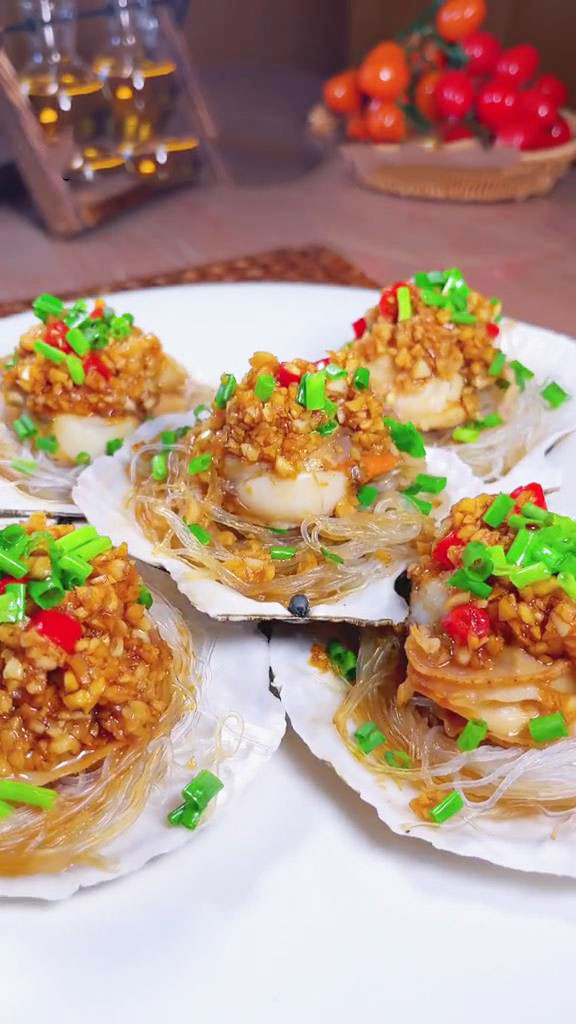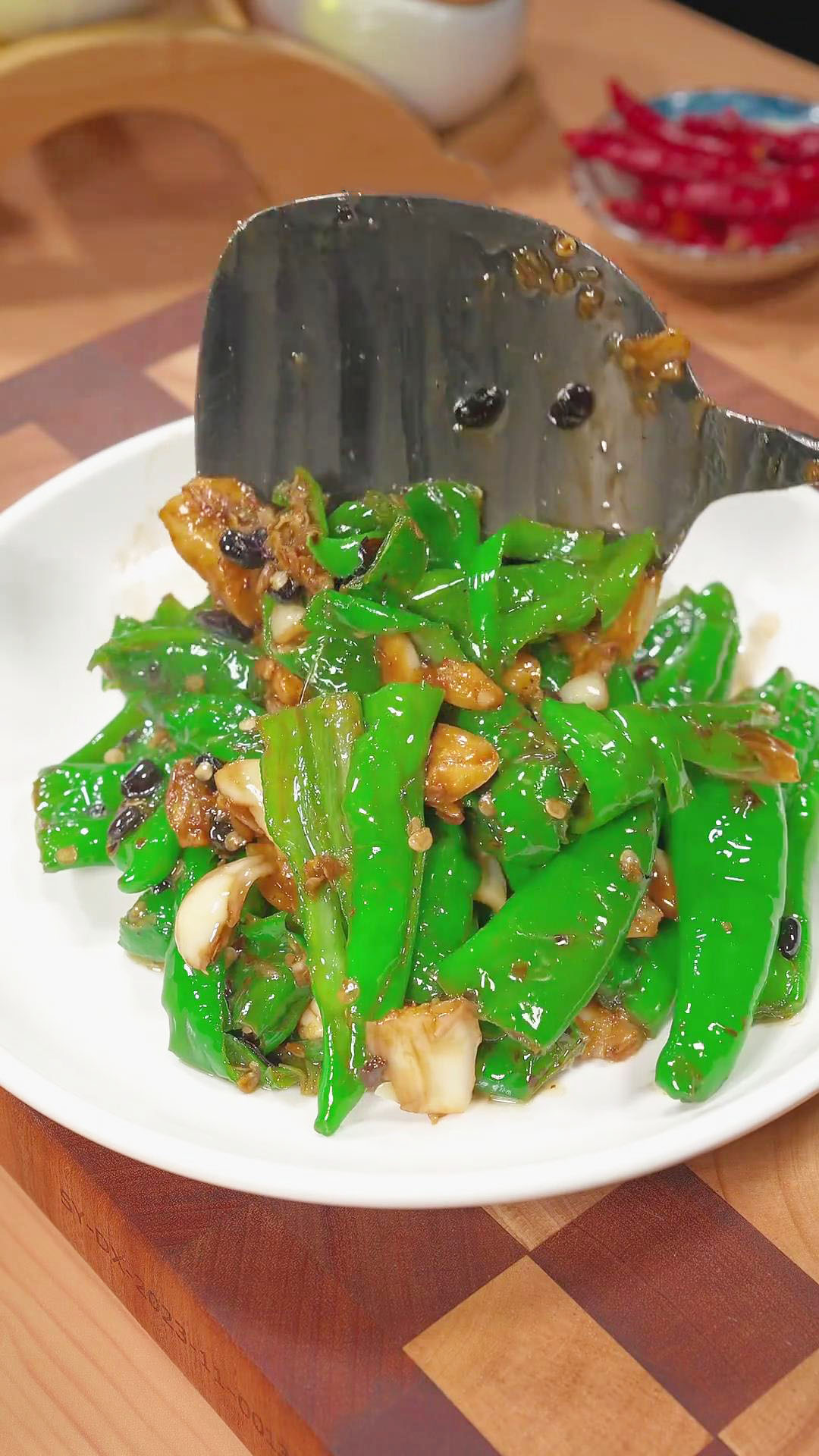This post may contain affiliate links. Please read our disclosure policy.
Experience a classic Sichuan dish with easy stir-fry yu xiang eggplant (鱼香茄子) in 8 easy steps. There’s something very special about the tangy, sweet, and umami yu xiang sauce that makes this dish stand out from the crowd. Make this with your choice of protein, whether you like it with minced meat, tofu, or mushrooms.
What Is Yu Xiang Eggplant (鱼香茄子)?
If you have come across my yu shiang chicken recipe, you should know that it is quite similar to yu xiang eggplant.
Instead of chicken, this recipe uses chopped eggplant mixed with minced meat and aromatics.
The special ingredient is the yu xiang sauce, which is a mix of water, Chinese black vinegar, light soy sauce, sugar, and cornstarch.
It is the perfect balance of salty, sweet, and sour as you enjoy the contrasting textures of crunchy, soft, and sticky.
Minced meat is optional since you can use plant-based alternatives such as crumbled tofu, minced soy meat, and minced mushrooms.
This dish is seasoned with flavoring ingredients, such as ginger, garlic, doubanjiang, bell peppers, and green onions.
It is interesting to note that yu xiang actually means “fish fragrant”. However, as you can see, there are no fish ingredients in the recipe. It may be called this way since the sauce is traditionally used for Sichuanese fish cooking.
More About Eggplant
Eggplant is a challenging vegetable to cook, as restaurants typically deep-fry it before stir-frying.
However, I’m not a big fan of deep-frying at home because it requires a lot of oil. So, I use an alternative method to cook it. Keep reading to find out more.
Ready to make this recipe? Continue reading my top tips and detailed steps below. Pair this dish with these Sichuan or Chinese dishes:
- Sichuan Wontons In Chili Oil (Spicy Chao Shou)
- Kung Pao Shrimp
- Tiger Salad
- Lotus Root Salad With Hot & Tangy Dressing
- Tofu Skin Rolls (Meaty Or All-Veggie)
- Jian Bing (Chinese Breakfast Crepe)
- Chinese Chive Pockets (Large Chinese Chive Dumplings)
- Chinese Tea Egg
- Eggplant And Minced Pork
- Celtuce Stir-Fry
- Sweet And Sour Pork Rib
- Boiled Okra With Spicy Savory Sauce
Ingredient Tips And Alternatives
If you want to learn more about the ingredients, such as preparation tips and best alternatives, continue reading this section.
- Eggplant: I use 1 large eggplant. Any type will do, such as Chinese eggplant, American eggplant, Italian eggplant, or Japanese eggplant. Chop the eggplant into thick 2-inch strips. You can also chop it into cubes or rounds if you like. Here are some tips to know about eggplants:
- Choose the right eggplant: Pick the ones that are firm and not too soft. It should have smooth and shiny skin without brown or soft spots.
- Marinate the chopped eggplant with salt: After chopping the eggplant, I recommend marinating it in salt for about 10 minutes. Once washed, squeeze out excess water from the eggplant with both hands. This crucial step helps soften the texture and remove excess moisture. In this way, it reduces its spongy texture, making it creamy instead. Moreover, this also helps prevent the eggplant from absorbing too much oil, resulting in a crispier texture and not soggy. If you want it to be crunchier, I suggest lightly coating the eggplant with cornstarch and then stir-frying it. This optional step should be done after washing and squeezing out excess water from the eggplant.
- Oil: Oil is needed to cook the minced meat with the aromatics. Use olive, avocado, sesame, or safflower oil for a healthier option. For a neutral taste, use peanut, soybean, or vegetable oil.
- Minced meat: I used about a bowl of minced meat, but you can add more or less and adjust the seasonings. If using meat cuts, simply blend it in a food processor to make minced meat. It is up to you if you want to use minced chicken, pork, beef, or turkey. For our vegetarian and vegan readers, swap the meat with plant-based options like minced soy meat, crumbled drained firm tofu, and minced shiitake mushrooms. If you want to learn more recipes using minced meat, here are some recipes to try:
- Sauce: Yu Xiang sauce is a combination of these basic ingredients: Chinese black vinegar, light soy sauce, sugar, and cornstarch. This is a shortcut version, but if you want a deeper complex flavor, follow my restaurant-style Chinese Yu Xiang sauce.
- Water: Water simply dilutes the sauce seasonings. Alternatively, you can add more depth by using chicken or vegetable stock. Adjust the amount to taste.
- Chinese black vinegar: The key ingredient for the sauce is Chinese black vinegar, also known as Chinkiang vinegar or Zhenjiang vinegar. It is fruity, tangy, and slightly sweet. You can get this in Asian stores, in the international section of grocery stores, or on Amazon. Alternatively, you can replace it with balsamic vinegar, date vinegar, or red wine vinegar, but the taste won’t be the same.
- Light soy sauce: Light soy sauce is a staple for a deep, salty, umami base. You can also use tamari, liquid aminos, coconut aminos, or gluten-free soy sauce.
- Sugar: Sugar balances the saltiness and tanginess of the sauce. Adjust the amount according to your desired level of sweetness. Any sugar will do, such as white sugar, cane sugar, brown sugar, maple syrup, or coconut sugar.
- Cornstarch: To make the sauce sticky and creamy, you will need a bit of cornstarch. The sauce’s sticky consistency gives the eggplant a nice sticky outer coating. If you don’t have cornstarch, use tapioca flour or potato starch. For 1 tbsp of cornstarch, substitute it with 1 tbsp of tapioca flour or 1 tbsp of potato starch.
- Flavoring ingredients: If you have read my Chinese Yu Xiang sauce recipe, you will find that I stir-fried a few aromatics with doubanjiang before mixing them with the main sauce. This eggplant recipe is quite similar. However, instead of mixing the stir-fried ingredients directly with the sauce, it is stir-fried with the minced meat first. Afterward, the eggplant and prepared sauce are mixed in.
- Ginger: I love ginger for its peppery, warm kick with a hint of sweetness. If you don’t have fresh ginger, swap it with 1/4 to 1/2 tsp ground ginger for every 1 tbsp of fresh ginger. In this way, you still get the delectable taste of ginger.
- Garlic: In combination with ginger, garlic is great for its nutty and pungent taste. Aside from fresh ginger, you can also incorporate pre-cooked crispy fried garlic if you have one. If you don’t have fresh garlic, use 1/8 tsp of garlic powder or 1/4 tsp of granulated garlic for every 1 garlic clove.
- Sweet soybean paste: Add that oomph with sweet soybean paste, also known as broad bean paste or doubanjiang. This Asian staple is loved for its umami, sweet, and spicy taste. It is made from fermented soybeans, which is why it has a complex, distinct taste. The closest fermented alternatives you can try are miso paste or hoisin sauce. It may not have the same flavor profile, but it is worth the try.
- Bell pepper: I used thinly sliced green and red bell peppers. I love bell peppers for their sweet crunch. To prepare, remove the seeds, remove the stem, clean, and cut into thin strips. Alternatively, thinly sliced yellow bell pepper and carrots can be used.
- Green onion: Green onions add a fresh, mild, oniony taste. I used the white parts only, but you may add the green parts. If you don’t have green onions, use chopped chives, shallots, white onions, yellow onions, or red onions.
Ingredients And Kitchenware
Here’s what to prepare for the recipe:
Kitchenware
- Knife and chopping board
- Bowl (for marinating)
- Mixing bowl (for the sauce)
- Frying pan
- Spatula
Ingredients (adjust to taste)
- 1 large eggplant (cut into 2-inch strips)
- Salt and water (for marinating)
- Sauce:
- 5 tablespoons water
- 4 tablespoons black vinegar
- 3 tablespoons light soy sauce
- 2 tablespoons white sugar
- 1 tablespoon corn starch
- 2 teaspoons Oil (for stir-frying)
- 1 cup (or more) minced meat
- 1/4 cup minced ginger
- 1/4 cup minced garlic
- 1-2 teaspoons doubanjiang
- 1/4 cup green bell peppers (thinly sliced)
- 1/4 cup red bell peppers (thinly sliced)
- 1/4 cup chopped green onions (white part)
8 Easy Steps To Cook Yu Xiang Eggplant (鱼香茄子)
In a nutshell, simply prepare the sauce, stir-fry the minced meat with the seasonings, and add the chopped eggplant and sauce. Finish the recipe in less than 30 minutes in 8 easy steps! Watch each step closely with my short tutorial video on Instagram or TikTok.
What do you think of this yu xiang eggplant recipe? How did you serve it? Share your thoughts and ideas in the comments section with the tag @kitchenmisadventures.
- Prepare the eggplant: Wash, remove the stem, slice crosswise in 2-inch pieces, then slice into thick long strips (about 2 inches long).

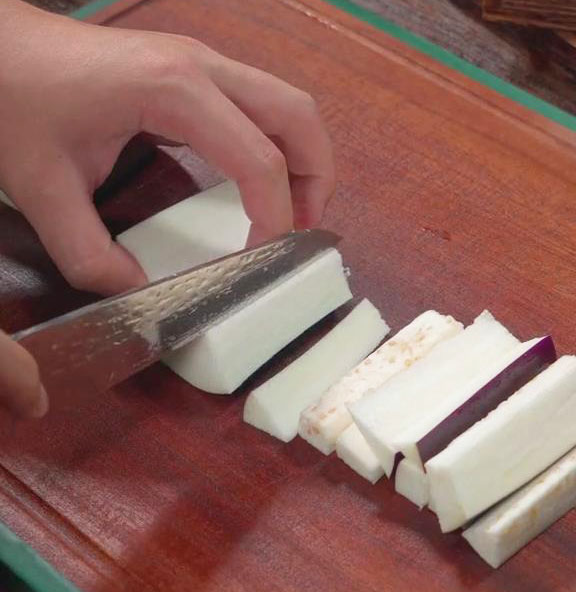
- Transfer the eggplant to a large bowl for marinating. Sprinkle it with a generous amount of salt and let it marinate for 10 minutes to draw out excess water. This step is needed to reduce its spongy texture and make it creamy and crisp. It also helps lessen the oil absorption during the stir-frying step.
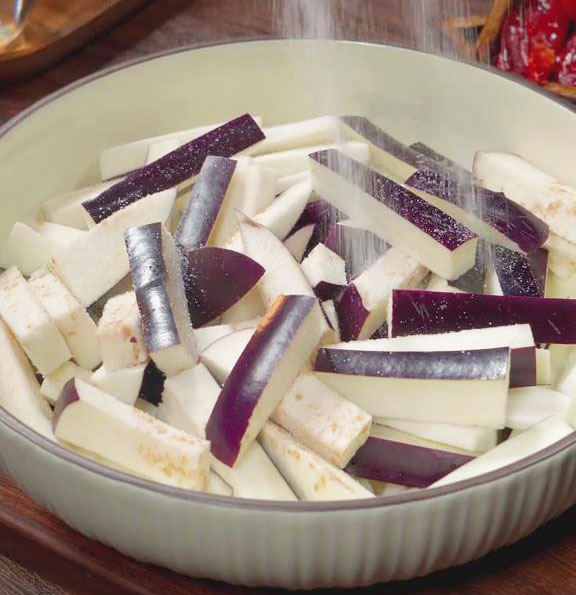
- After marinating, rinse off the excess salt with water. Then, drain as much water as you can and squeeze out any remaining excess water from the eggplant with both hands.
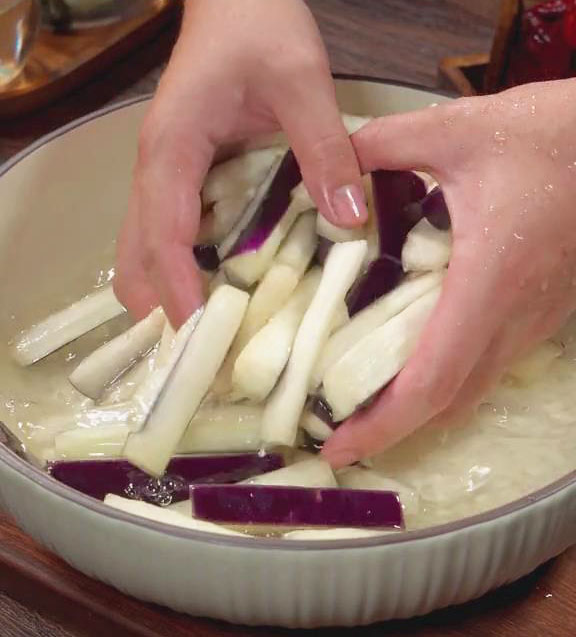
- In the meantime, make the sauce: Combine water, Chinese black vinegar, light soy sauce, sugar, and cornstarch. Mix well and set aside. At this step, you can go ahead with chopping the other fresh vegetables, such as ginger, garlic, green bell pepper, red bell pepper, and green onions.
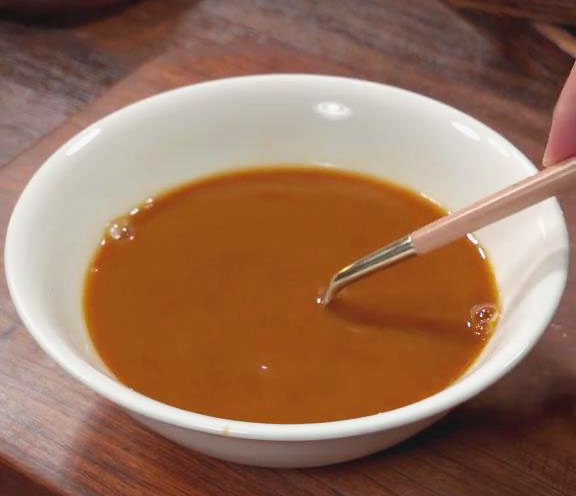
- Heat oil in a pan and stir-fry minced meat until light brown.
- Mix in minced ginger, garlic, and doubanjiang. Continue stirring until the seasonings are well-mixed and the minced meat takes the color of the doubanjiang (slightly red).
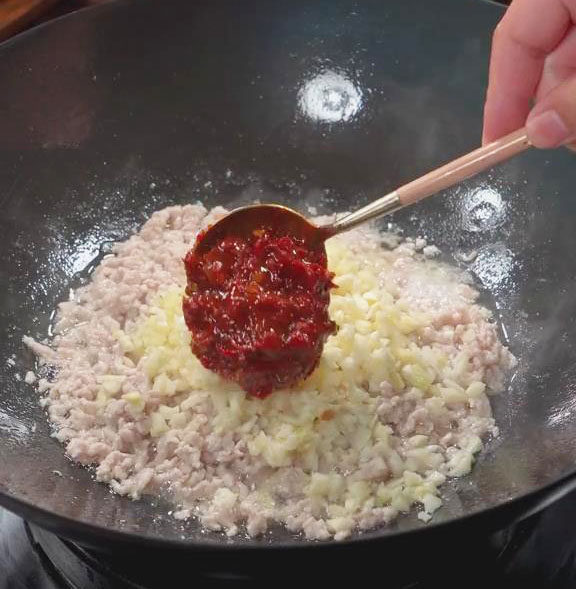
- Next, add the chopped eggplant and the prepared sauce, stir well, and cook until the flavors meld. Remember to mix the sauce once more before pouring it into the pan since the cornstarch tends to settle at the bottom of the bowl.
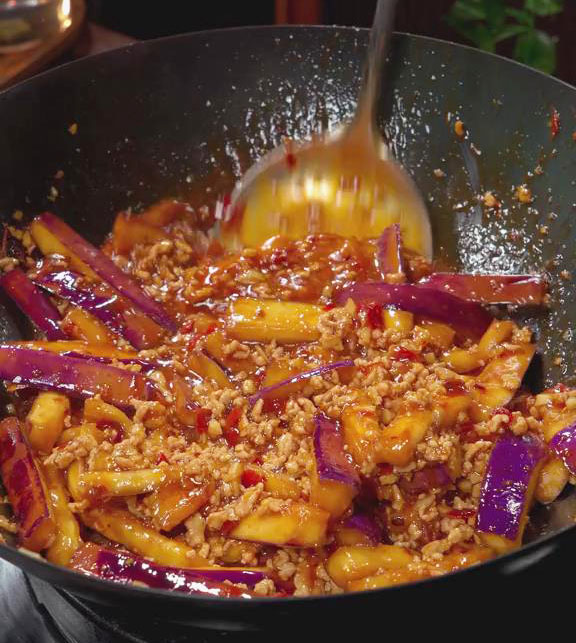
- Finally, add thinly sliced green and red bell peppers and chopped green onion. Stir-fry briefly over high heat, and you’re done! I recommend chopping the bell peppers and onions ahead of time to avoid over-frying the eggplant. If the eggplant is cooked too much, it will turn soggy and lose its bright purple color.
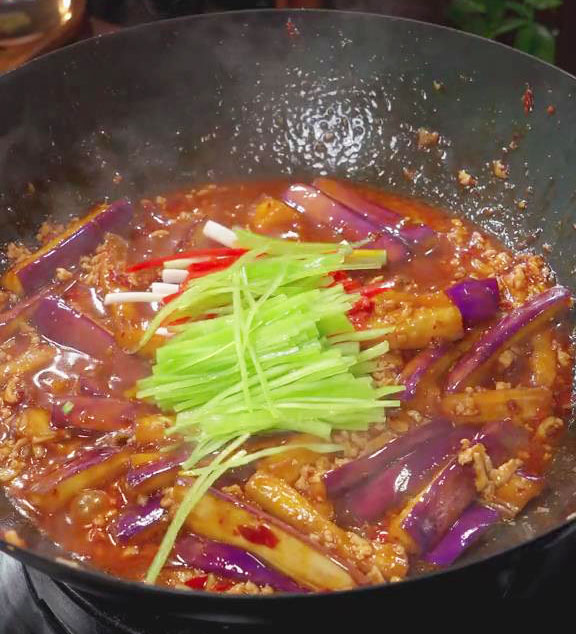
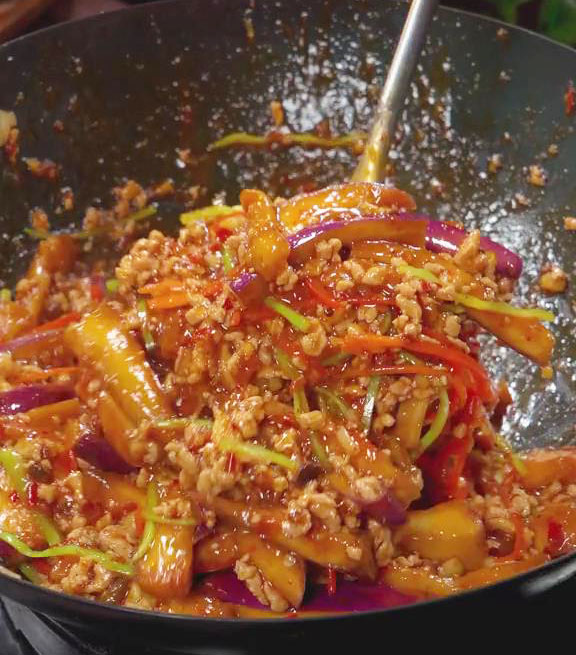
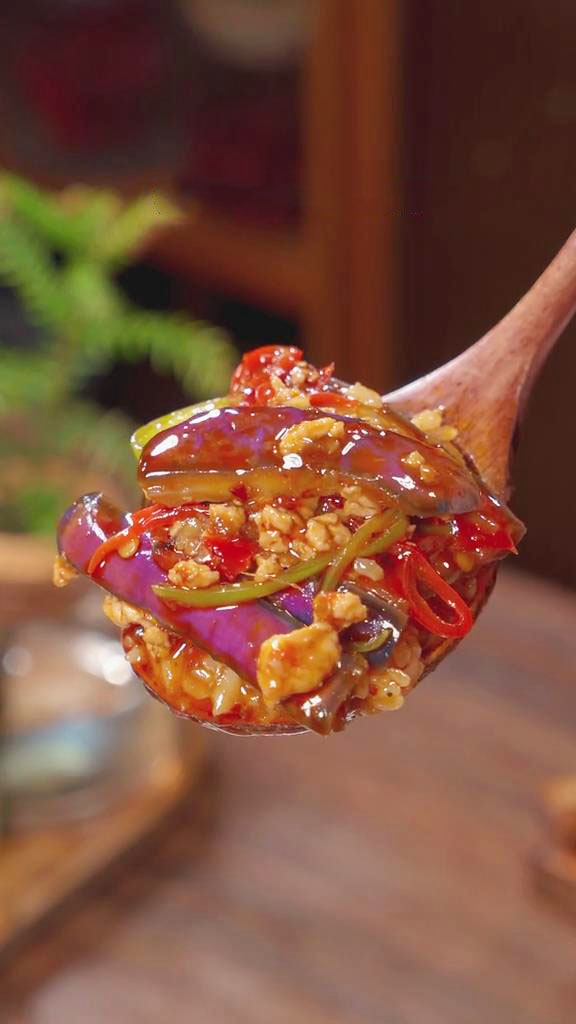
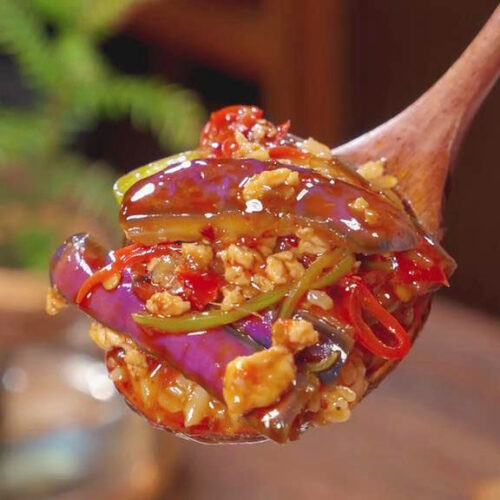
Yu Xiang Eggplant Recipe
Experience a classic Sichuan dish with easy stir-fry yu xiang eggplant (鱼香茄子) in 8 easy steps. There's something very special about the tangy, sweet, and umami yu xiang sauce that makes this dish stand out from the crowd. Make this with your choice of protein, whether you like it with minced meat, tofu, or mushrooms.Ingredients
- 1 large eggplant cut into 2-inch strips
- Salt and water for marinating
Sauce:
- 5 tablespoons water
- 4 tablespoons black vinegar
- 3 tablespoons light soy sauce
- 2 tablespoons white sugar
- 1 tablespoon corn starch
Other Ingredients
- 2 tablespoons Oil for stir-frying
- 1 cup or more minced meat
- 1/4 cup minced ginger
- 1/4 cup minced garlic
- 1-2 teaspoons doubanjiang
- 1/4 cup green bell peppers thinly sliced
- 1/4 cup red bell peppers thinly sliced
- 1/4 cup chopped green onions white part
Instructions
- Prepare the eggplant: Wash, remove the stem, slice crosswise in 2-inch pieces, then slice into thick long strips (about 2 inches long).
- Transfer the eggplant to a large bowl for marinating. Sprinkle it with a generous amount of salt and let it marinate for 10 minutes to draw out excess water. This step is needed to reduce its spongy texture and make it creamy and crisp. It also helps lessen the oil absorption during the stir-frying step.
- After marinating, rinse off the excess salt with water. Then, drain as much water as you can and squeeze out any remaining excess water from the eggplant with both hands.
- In the meantime, make the sauce: Combine water, Chinese black vinegar, light soy sauce, sugar, and cornstarch. Mix well and set aside. At this step, you can go ahead with chopping the other fresh vegetables, such as ginger, garlic, green bell pepper, red bell pepper, and green onions.
- Heat oil in a pan and stir-fry minced meat until light brown.
- Mix in minced ginger, garlic, and doubanjiang. Continue stirring until the seasonings are well-mixed and the minced meat takes the color of the doubanjiang (slightly red).
- Next, add the chopped eggplant and the prepared sauce, stir well, and cook until the flavors meld. Remember to mix the sauce once more before pouring it into the pan since the cornstarch tends to settle at the bottom of the bowl.
- Finally, add thinly sliced green and red bell peppers and chopped green onion. Stir-fry briefly over high heat, and you're done! I recommend chopping the bell peppers and onions ahead of time to avoid over-frying the eggplant. If the eggplant is cooked too much, it will turn soggy and lose its bright purple color.
Video
Nutrition
Calories: 607kcalCarbohydrates: 43gProtein: 27gFat: 37gSaturated Fat: 10gPolyunsaturated Fat: 5gMonounsaturated Fat: 19gTrans Fat: 1gCholesterol: 80mgSodium: 1662mgPotassium: 1141mgFiber: 9gSugar: 24gVitamin A: 1688IUVitamin C: 75mgCalcium: 93mgIron: 4mgTried this recipe?Let us know how it was!

